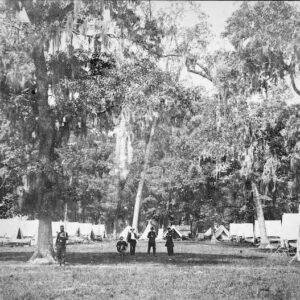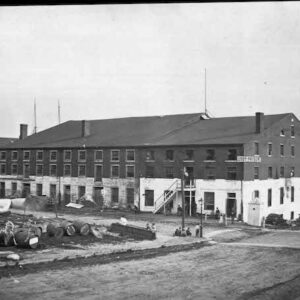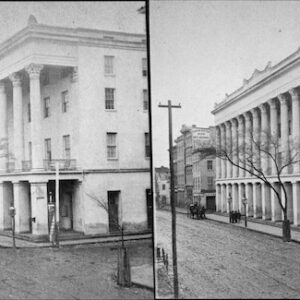Tag: by Cook (George S.)
 Wikipedia says: The most renowned Southern photographer was George Smith Cook (1819–1902). The native of Stamford, Connecticut was not successful in the mercantile business, so he moved to New Orleans and became a portrait painter. This proved unprofitable and in 1842 Cook began working with the “new art” of the daguerreotype, settling in Charleston, South Carolina, where he raised a family. Cook’s status as one of the South’s most famous photographers was due in part to his visit to Fort Sumter on Feb. 8, 1861, which resulted in the first mass marketing of cartes-de-visite, a photograph of the fort’s commander, Maj. Robert Anderson. A successful portrait business that survived the war, and the systematic documentation of Union shelling of Charleston and in particular, Fort Sumter added to Cook’s fame. Then, on September 8, 1863 he and business partner James Osborn photographed the inside of Fort Sumter, and as luck would have it, also captured the developing naval action in the harbor, Federal ironclads firing on Fort Moultrie. The historic images depict three ironclad monitors and U.S.S. New Ironsides firing on Fort Moultrie in defense of monitor U.S.S. Weehawken, grounded off Cummings Point. For unknown reasons, the historic stereoview was not marketed until 1880, when it was finally offered for sale by Cook’s son, George LaGrange Cook. Sadly, Cook’s extensive collection, mainly consisting of portraits of notable Southern personalities, was lost on Feb. 17, 1865, when his Columbia, S.C. studio was destroyed during the firestorm that engulfed the capitol city. Cook moved his family to Richmond in 1880, and his older son, George LaGrange Cook, took charge of the studio in Charleston. In Richmond, Cook bought up the businesses of photographers who were retiring, or moving from the city. He thus amassed the most comprehensive collection of prints and negatives of the former Confederate capital known to exist. Cook remained an active photographer for the remainder of his life. In 1891, one year before George’s death, George Jr. joined his father and younger brother Huestis in Richmond. After George Jr’s death in 1919, Huestis took over the Richmond studio.
Wikipedia says: The most renowned Southern photographer was George Smith Cook (1819–1902). The native of Stamford, Connecticut was not successful in the mercantile business, so he moved to New Orleans and became a portrait painter. This proved unprofitable and in 1842 Cook began working with the “new art” of the daguerreotype, settling in Charleston, South Carolina, where he raised a family. Cook’s status as one of the South’s most famous photographers was due in part to his visit to Fort Sumter on Feb. 8, 1861, which resulted in the first mass marketing of cartes-de-visite, a photograph of the fort’s commander, Maj. Robert Anderson. A successful portrait business that survived the war, and the systematic documentation of Union shelling of Charleston and in particular, Fort Sumter added to Cook’s fame. Then, on September 8, 1863 he and business partner James Osborn photographed the inside of Fort Sumter, and as luck would have it, also captured the developing naval action in the harbor, Federal ironclads firing on Fort Moultrie. The historic images depict three ironclad monitors and U.S.S. New Ironsides firing on Fort Moultrie in defense of monitor U.S.S. Weehawken, grounded off Cummings Point. For unknown reasons, the historic stereoview was not marketed until 1880, when it was finally offered for sale by Cook’s son, George LaGrange Cook. Sadly, Cook’s extensive collection, mainly consisting of portraits of notable Southern personalities, was lost on Feb. 17, 1865, when his Columbia, S.C. studio was destroyed during the firestorm that engulfed the capitol city. Cook moved his family to Richmond in 1880, and his older son, George LaGrange Cook, took charge of the studio in Charleston. In Richmond, Cook bought up the businesses of photographers who were retiring, or moving from the city. He thus amassed the most comprehensive collection of prints and negatives of the former Confederate capital known to exist. Cook remained an active photographer for the remainder of his life. In 1891, one year before George’s death, George Jr. joined his father and younger brother Huestis in Richmond. After George Jr’s death in 1919, Huestis took over the Richmond studio.
Note: The famous “exploding shell” photo falsely attributed to Cook is in reality a painting by C.S.A. Lt. John R. Key, based on three half stereos taken by Cook inside Fort Sumter on Sept. 8, 1863. Experts had overlooked the fact that no camera of the time was capable of taking the wide angle depicted.
Showing 1–16 of 20 resultsSorted by latest
-

Image ID: AZLY
$3.99 -

Image ID: AMLC
$0.99 -

Image ID: ARWZ
$4.99 -

Image ID: ARXA
$5.99 -

Image ID: AOXN
$6.99 -

Image ID: APSG
$0.99 – $5.99 This product has multiple variants. The options may be chosen on the product page -

Image ID: AQJO
$5.99 -

Image ID: ARZP
$5.99 -

Image ID: ARZQ
$5.99 -

Image ID: ASAR
$5.99 -

Image ID: AOXM
$6.99 -

Image ID: ARWY
$5.99 -

Image ID: AOXR
$6.99 -

Image ID: AOXV
$3.99 -

Image ID: AOXW
$0.99 – $3.99 This product has multiple variants. The options may be chosen on the product page -

Image ID: AOXX
$5.99